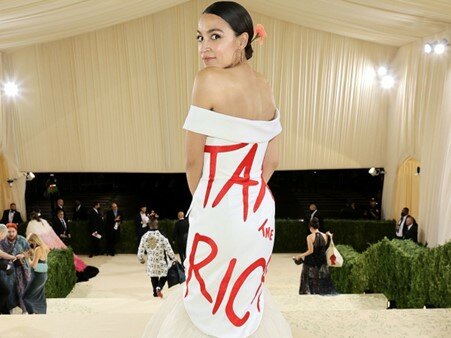Edited by Maria Noujaim
Everyone remembers Lady Gaga’s infamous “meat dress” from the 2010 MTV Video Music Awards, one of the most outrageous fashion statements to date. Gaga’s look, made up of an estimated 50-pounds of raw meat, sparked considerable controversy and was received badly, especially by animal rights activists such as PETA who strongly condemned the dress. In response to the controversy, the artist claimed it was a statement about one’s need to fight for what one believes in, as well as a way for her to express her distaste for the US military’s “don’t ask, don’t tell policy” instituted under the Clinton administration, it allowed gay, lesbian, and bisexual Americans to serve their country, but required them to keep their sexual identity hidden. That being said, if you go around asking people today what Lady Gaga’s intentions were, most would not be able to tell you about the political motivations behind the dress.
Fashion has a significant influence on today’s society, with many using it as a tool for self-expression of both personal and political beliefs. It is then no surprise that many celebrities and public figures cease the opportunity to convey a certain message through their outfits on some of the most televised award shows and ceremonies. Every year as the Oscars and the Met Gala roll around, all eyes are on the attendees, as people anxiously await to see their outfits, and the media quickly compile “best/worst dressed” lists.
It is safe to say clothes have a way of getting people to talk. However, as we have seen with Lady Gaga’s “meat dress”, the alleged message behind the statement piece is often lost in translation, making us question the legitimacy of the celebrity’s intentions, as after all, there were certainly more effective ways for Gaga to express her distaste for the US military’s controversial policy.
In 2021, New York representative Alexandria Ocasio-Cortez (AOC) attended the Met Gala, known globally as “Fashion’s Biggest Night” and “Celebrities’ Biggest Night”, in a white gown with the words “Tax The Rich” imprinted on the back in bright red. AOC’s look sparked controversy, with some commending her bold statement, and many criticizing the message behind her look for several reasons.
The Met Gala is renowned for being extravagant and high-priced, with tickets costing $35,000 and tables as far as $200,000 to $300,000. While AOC hit back at critics in an Instagram post explaining she was invited to the event and thus did not have to pay the hefty ticket price, many remained unconvinced and condemned her very attendance to the event alongside Hollywood’s elite. As a legislator, she already has the power to induce change so it was questionable that she chose to wear a dress to convey a political message instead.
Many felt that the New York representative would have done better by boycotting the event altogether and using her position to demand the very thing she put on her dress. The outfit was also labeled a walking contradiction: a costly custom designer dress being paraded around the highest of the elites at the most lavish of events while demanding the rich be taxed, making for an overall tone-deaf move on AOC’s part. AOC did take to Instagram to defend herself by saying the dress’ designer is indigeneous, but failed to mention the fact that the designer herself is a millionaire, making the statement even more ironic.
Also in attendance at the 2021 Met Gala was model and actress Cara Delevigne, who went for an equally daring outfit that gave way for just as much backlash. Delevigne’s outfit consisted of an all white ensemble, the top being a Dior bulletproof vest displaying the words “Peg the Patriarchy” in red. “It’s about women empowerment, gender equality,” the English model told Vogue at the event. What she failed to mention, however, is the name of the creator of the slogan, black queer sex educator Luna Matatas, who trademarked it back in 2018.
Matatas felt that Delevigne’s use of the slogan misinterpreted the original intentions behind “peg the patriarchy”. When taken out of context, the term pegging here insinuates that penetration is inherently degrading, whereas Matatas explained in an Instagram post that to her, the slogan means “subverting a system of oppression that impacts all genders and is upheld by the behaviours and ideas of [white] colonial masculinity”. Delevigne’s lack of crediting is also a direct contradiction of the very message on her top. “It’s such an extension of the tools of patriarchy to have competition, to have very callous ways of being in the same spaces together. We’re both feminists, let’s lift each other up,” Matatas told US-based website Jezebel. Due to its poor execution, the look came off as performative and ingenuine and arguably, did more harm than good.
Most recently, Hillary Clinton attended the 2022 Met Gala in a dress embroidered with the names of around 60 American women who inspire her such as Abigail Adams and Harriet Tubman. Her look received backlash online with many taking to Twitter to call out the shocking irony of Hillary Clinton, who’s interference in Libya led to the country now having open air slave markets, wearing a dress with Harriet Tubman’s name, an American abolitionist who played a key role in the rescue of around 70 enslaved people.
The significant controversy these politically-charged looks created is telling of fashion’s ability to get people talking. However, at most, getting people to talk will lead to a spike in Google searches for “Tax the Rich” or “Peg the Patriarchy”, which realistically doesn’t directly do anything to improve the plight of marginalized people. With the $35,000 price of a single Met Gala ticket, at least 4 to 5 families could be put over the poverty line in the US. So when put in perspective, a dress like AOC’s is distasteful, making us wonder if there is a place for activism in fashion. Activism through fashion can be done through sustainable fashion choices such as thrifting, mending old clothes, and limiting our consumption. Wearing a gown made with sustainable materials and by well-paid dressmakers is a much more powerful tool than writing a political message on a garment that violates sustainable fashion practices, as it actively takes a stand against an industry that abuses its workers and destroys the environment.



